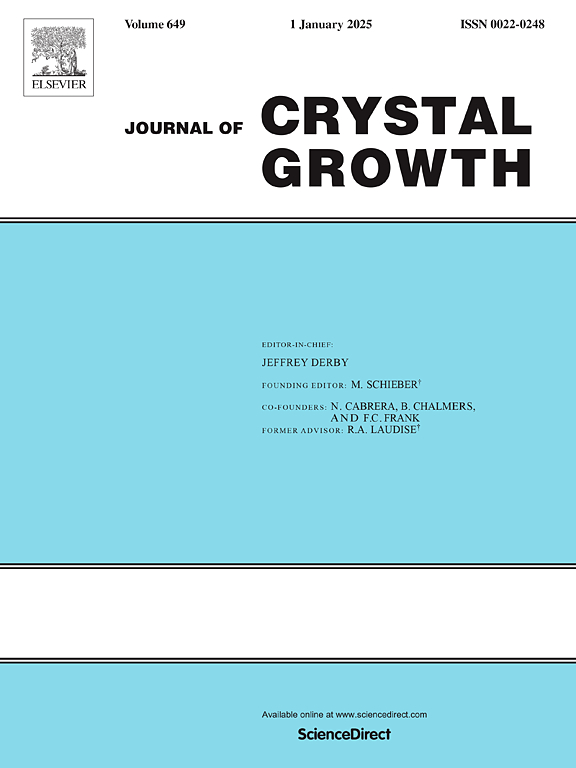Influence of the crystal size and chemical composition on the optical properties of diamond films grown by hot filament chemical vapor deposition
IF 2
4区 材料科学
Q3 CRYSTALLOGRAPHY
引用次数: 0
Abstract
This article is focused on describing the optical properties of different polycrystalline diamond thin films grown by hot filament chemical vapor deposition (HFCVD). The study correlates the influence of the crystal size and the composition to the optical properties of the diamond thin films. It was found that the diamond films grain sizes are depending on the precursor gases flow rates during film growth. All diamond films grown in this work exhibit the Raman peak corresponding to the G-band signal at 1560 cm−1 associated to C–C sp2 chemical bonds of C atoms in gran boundaries. Ellipsometry was used to determine the optical constants and refractive index of these polycrystalline diamond films using light beam 633 nm wavelength. The refractive index for micro-crystalline diamond (MCD) and nano-crystalline diamond (NCD) films was 2.33 and the ultra-nanocrystalline (UNCD) films presented a refractive index of 2.62. This research is an attempt to provide valuable information on the relation between the films structure, surface topography, chemical composition, and optical properties for a series of polycrystalline diamond films grown by HFCVD. The polycrystalline diamond films synthetized in this work should find applications in the fabrication of sensors, planar waveguide and in the development of opto-electronic devices.
晶体尺寸和化学成分对热丝化学气相沉积金刚石薄膜光学性能的影响
本文主要描述了热丝化学气相沉积法(HFCVD)生长的不同多晶金刚石薄膜的光学性质。研究了晶体尺寸和组成对金刚石薄膜光学性能的影响。研究发现,金刚石薄膜的晶粒大小与薄膜生长过程中前驱体气体的流速有关。在本研究中生长的所有金刚石薄膜在1560 cm−1处显示与C原子的C - C sp2化学键相关的g波段信号对应的拉曼峰。在633 nm波长的光束下,用椭偏法测定了这些多晶金刚石薄膜的光学常数和折射率。微晶金刚石(MCD)和纳米晶金刚石(NCD)薄膜的折射率为2.33,超纳米晶金刚石(UNCD)薄膜的折射率为2.62。本研究试图为HFCVD生长的多晶金刚石薄膜的结构、表面形貌、化学成分和光学性质之间的关系提供有价值的信息。本文所合成的多晶金刚石薄膜在传感器、平面波导的制造以及光电器件的开发等方面具有广泛的应用前景。
本文章由计算机程序翻译,如有差异,请以英文原文为准。
求助全文
约1分钟内获得全文
求助全文
来源期刊

Journal of Crystal Growth
化学-晶体学
CiteScore
3.60
自引率
11.10%
发文量
373
审稿时长
65 days
期刊介绍:
The journal offers a common reference and publication source for workers engaged in research on the experimental and theoretical aspects of crystal growth and its applications, e.g. in devices. Experimental and theoretical contributions are published in the following fields: theory of nucleation and growth, molecular kinetics and transport phenomena, crystallization in viscous media such as polymers and glasses; crystal growth of metals, minerals, semiconductors, superconductors, magnetics, inorganic, organic and biological substances in bulk or as thin films; molecular beam epitaxy, chemical vapor deposition, growth of III-V and II-VI and other semiconductors; characterization of single crystals by physical and chemical methods; apparatus, instrumentation and techniques for crystal growth, and purification methods; multilayer heterostructures and their characterisation with an emphasis on crystal growth and epitaxial aspects of electronic materials. A special feature of the journal is the periodic inclusion of proceedings of symposia and conferences on relevant aspects of crystal growth.
 求助内容:
求助内容: 应助结果提醒方式:
应助结果提醒方式:


